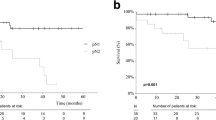Abstract
Log odds of positive nodes (LODDS), defined as the log of the ratio between the number of positive nodes and the number of negative nodes, has been recently introduced as a tool in predicting prognosis. This study aims to establish the effective and prognostic value of LODDS in predicting the survival outcome of CRC patients undergoing surgical resection. The study population is represented by 323 consecutive patients with primary colon or rectal adenocarcinoma thatunderwent curative resection. LODDS values were calculated by empirical logistic formula, log(pnod + 0.5)/(tnod − pnod + 0.5). It was defined as the log of the ratio between the number of positive nodes and the number of negative nodes. The patients were divided into three groups: LODDS0 (≤ − 1.36), LODDS1 (> − 1.36 ≤ − 0.53) and LODDS2 (> − 0.53). Kaplan–Meier curve analyses showed 3-year OS rates of the patients staged by LODDS classification. These values were 88.3, 74.8 and 61.8% for LODDS0, LODDS1 and LODDS2, respectively (P ≤ 0.001). In a multivariate analysis, LODDS is an independent prognostic factor of 3-year OS. This is in contrast to pN stage and lymph node ratio, which shows no statistical significance. ROC analyses showed that LODDS predicted OS better than lymph node ratio. LODDS classification has a better prognostic effect than pN stage and lymph node ratio. LODDS offers a finer stratification and accurately predicts survival of CRC patients.




Similar content being viewed by others
References
Jemal A, Siegel R, Xu J et al (2010) Cancer statistics. CA Cancer J Clin 60:277–300
Nelson H, Petrelli N, Carlin A et al (2001) Guidelines 2000 for colon and rectal cancer surgery. J Natl Cancer Inst 93:583–596
Sobin LH, Gospodarowicz MK, Wittekind C (2010) TNM classification of malignant tumors, 7th edn. Wiley-Blackwell, Oxford
Compton C, Fenoglio-Preiser CM, Pettigrew N, Colorectal Working Group et al (2000) American Joint Committee on Cancer prognostic factors consensus conference. Cancer 88:1739–1757
Engstrom PF, Benson AB 3rd, Chen YJ et al (2005) Colon cancer clinical practice guidelines in oncology. J Natl Compr Cancer Netw 3:468–491
National Comprehensive Cancer Network (NCCN) Clinical practice guidelines in oncology (NCCN Guidelines TM). Colon cancer. Version 3.2011. http://www.nccn.org
Stocchi L, Fazio VW, Lavery I et al (2011) Individual surgeon, pathologist, and other factors affecting lymph node harvest in stage II colon carcinoma. Is a minimum of 12 examined lymph nodes sufficient? Ann Surg Oncol 2(18):405–412
Goldstein NS (2002) Lymph node recoveries from 2427 pT3 colorectal resection specimens spanning 45 years: recommendations for a minimum number of recovered lymph nodes based on predictive probabilities. Am J Surg Pathol 26:179–189
Sarli L, Bader G, Iusco D et al (2005) Number of lymph nodes examined and prognosis of TNM stage II colorectal cancer. Eur J Cancer 41:272–279
Swanson RS, Compton CC, Stewart A et al (2003) The prognosis of T3N0 colon cancer is dependent on the number of lymph nodes examined. Ann Surg Oncol 10:65–71
Baxter NN, Virnig DJ, Rothenberger DA et al (2005) Lymph node evaluation in colorectal cancer patients: a population-based study. J Natl Cancer Inst 97:219–225
Lu YJ, Lin PC, Lin CC et al (2013) The impact of the lymph node ratio is greater than traditional lymph node status in stage III colorectal cancer patients. World J Surg 37:1927–1933
Rosenberg R, Friederichs J, Schuster T et al (2008) Prognosis of patients with colorectal cancer is associated with lymph node ratio: a single-center analysis of 3,026 patients over a 25-year time period. Ann Surg 248:968–978
Wang J, Hassett JM, Dayton MT et al (2008) The prognostic superiority of log odds of positive lymph nodes in stage III colon cancer. J Gastrointest Surg 12:1790–1796
Arslan NC, Sokmen S, Canda AE et al (2014) The prognostic impact of log odds of positive lymph nodes in colon cancer. Colorectal Dis 16(11):O386–O392
Persiani R, Cananzi FC, Biondi A et al (2012) Log odds of positive lymph nodes in colon cancer: a meaningful ratio-based lymph node classification system. World J Surg 36:667–674
Song YX, Gao P, Wang ZN et al (2011) Which is the most suitable classification for colorectal cancer, log odds, the number or the ratio of positive lymph nodes? PLoS One 6(12):e28937
Compton CC, Fielding LP, Burgart LJ et al (2000) Prognostic factors in colorectal cancer. College of American Pathologists Consensus Statement 1999. Arch Pathol Lab Med 124:979–994
Edge SB, Byrd DR, Compton CC et al (2010) AJCC cancer staging manual, 7th edn. Springer, New York
Okusa T, Nakane Y, Boku T et al (1990) Quantitative analysis of nodal involvement with respect to survival rate after curative gastrectomy for carcinoma. Surg Gynecol Obstet 170(6):488–494
Siewert JR, Bottcher K, Stein HJ et al (1998) Relevant prognostic factors in gastric cancer: ten-year results of the German Gastric Cancer Study. Ann Surg 228(4):449–461
Aurello P, Petrucciani N, Nigri GR et al (2014) Log odds of positive lymph nodes (LODDS): what are their role in the prognostic assessment of gastric adenocarcinoma? J Gastrointest Surg 18(7):1254–1260
Sun Z, Xu Y, de Li M et al (2010) Log odds of positive lymph nodes: a novel prognostic indicator superior to the number-based and the ratio-based N category for gastric cancer patients with R0 resection. Cancer 116(11):2571–2580
Author information
Authors and Affiliations
Corresponding author
Ethics declarations
Conflict of interest
The authors declare that there is no potential conflict of interest.
Research involving human participants and/or animals
All procedures followed were in accordance with the ethical standards of the responsible committee on human experimentation (Institutional and National) and with the Helsinki Declaration of 1964 and later versions.
Informed consent
Informed consent was obtained from all patients for being included in the study.
Rights and permissions
About this article
Cite this article
Scarinci, A., Di Cesare, T., Cavaniglia, D. et al. The impact of log odds of positive lymph nodes (LODDS) in colon and rectal cancer patient stratification: a single-center analysis of 323 patients. Updates Surg 70, 23–31 (2018). https://doi.org/10.1007/s13304-018-0519-3
Received:
Accepted:
Published:
Issue Date:
DOI: https://doi.org/10.1007/s13304-018-0519-3




